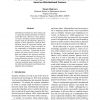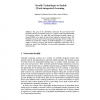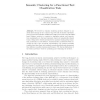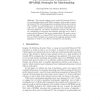322 search results - page 24 / 65 » Learning consumer preferences using semantic similarity |
ACL
2008
13 years 11 months ago
2008
Distributional similarity has been widely used to capture the semantic relatedness of words in many NLP tasks. However, various parameters such as similarity measures must be hand...
SIGIR
2008
ACM
13 years 9 months ago
2008
ACM
We study in this paper the problem of bridging the semantic gap between low-level image features and high-level semantic concepts, which is the key hindrance in content-based imag...
ECTEL
2007
Springer
14 years 3 months ago
2007
Springer
Abstract. The goal of the APOSDLE (Advanced Process-Oriented SelfDirected Learning environment) project is to support work-integrated learning of knowledge workers. We argue that w...
CICLING
2009
Springer
14 years 10 months ago
2009
Springer
Abstract. We describe a semantic clustering method designed to address shortcomings in the common bag-of-words document representation for functional semantic classification tasks....
ESWS
2008
Springer
13 years 11 months ago
2008
Springer
Abstract. This research explores a new method for Semantic Web service matchmaking based on iSPARQL strategies, which enables to query the Semantic Web with techniques from traditi...




